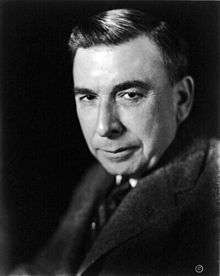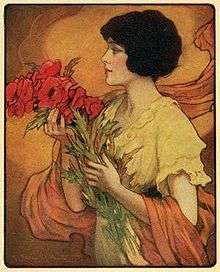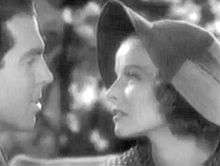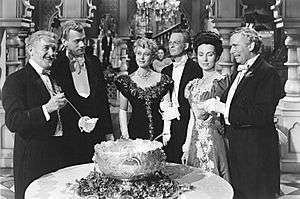Booth Tarkington
| Booth Tarkington | |
|---|---|
 Booth Tarkington (1922) | |
| Born |
Newton Booth Tarkington July 29, 1869 Indianapolis, Indiana, United States |
| Died |
May 19, 1946 (aged 76) Indianapolis, Indiana, United States |
| Occupation | Novelist and dramatist |
| Years active | 1899–1946 |
Newton Booth Tarkington (July 29, 1869 – May 19, 1946) was an American novelist and dramatist best known for his novels The Magnificent Ambersons and Alice Adams. He is one of only three novelists to win the Pulitzer Prize for Fiction more than once, along with William Faulkner and John Updike.
Biography
Booth Tarkington was born in Indianapolis, Indiana, the son of John S. Tarkington and Elizabeth Booth Tarkington. He was named after his maternal uncle Newton Booth, then the governor of California. He was also related to Chicago Mayor James Hutchinson Woodworth through Woodworth's wife Almyra Booth Woodworth.
Tarkington first attended Shortridge High School in Indianapolis, but completed his secondary education at Phillips Exeter Academy, a boarding school on the East Coast.[1] He attended Purdue University for two years, where he was a member of the Sigma Chi Fraternity and the university's Morley Eating Club. He later made substantial donations to Purdue for building an all-men's residence hall, which the university named Tarkington Hall in his honor. Purdue awarded him an honorary doctorate.[2]
"Tark" at Princeton
Some of his family's wealth returned after the Panic of 1873, and his mother transferred Booth from Purdue to Princeton University. At Princeton, Tarkington is said to have been known as "Tark" among his fellow Eating Club members. He was active as a student-actor and served as president of Princeton's Dramatic Association, which later became the Triangle Club. According to Triangle's official history,[3] Tarkington made his first acting appearance in the club's Shakespearean spoof Katherine. This was one of the first three productions in the Triangle's history that was written and produced by Princeton students. Tarkington established this Triangle tradition for productions of students' plays, and it remains to the present day.[4] Tarkington returned to the Triangle stage as Cassius in the 1893 production The Honorable Julius Caesar. He gained prominence that year at Princeton as a co-author of the play. In addition to his role as a founding member of The Triangle Club, he was also among the earliest members of the Ivy Club, the first of Princeton's historic Eating Clubs. He edited the Princeton's Nassau Literary Magazine, known more recently as The Nassau Lit.[5] While an undergraduate, he is known to have socialized with Woodrow Wilson, an associate graduate member of the Ivy Club. Wilson returned to Princeton as a member of the political science faculty shortly before Tarkington matriculated; they maintained contact throughout Wilson's life. Tarkington failed to earn his undergraduate degree of A.B. because of missing a single course in the classics. Nevertheless, his place within campus society was already determined, and he was voted "most popular" by the class of 1893.
Awards
In his adult life, he was twice asked to return to Princeton for the conferral of honorary degrees, an A.M. in 1899 and a Litt.D. in 1918. The conferral of more than one honorary degree on an alumnus(a) of Princeton University remains a university record.
While Tarkington never earned a college degree, he was accorded many awards recognizing and honoring his skills and accomplishments as an author. He won the Pulitzer Prize in fiction twice, in 1919 and 1922, for his novels The Magnificent Ambersons and Alice Adams. In 1921 booksellers rated him "the most significant contemporary American author" in a poll conducted by Publishers' Weekly. He won the O. Henry Memorial Award in 1931 for his short story "Cider of Normandy". His works appeared frequently on best sellers lists throughout his life. In addition to his honorary doctorate from Purdue, and his honorary masters and doctorate from Princeton, Tarkington was awarded an honorary doctorate from Columbia University, the administrator of the Pulitzer Prize, and several other universities.
Many aspects of Tarkington's Princeton years and adult life were paralleled by the later life of another writer, fellow Princetonian F. Scott Fitzgerald.
Tarkington as "The Midwesterner"

Tarkington was an unabashed Midwestern regionalist and set much of his fiction in his native Indiana. In 1902, he served one term in the Indiana House of Representatives as a Republican. Tarkington saw such public service as a responsibility of gentlemen in his socio-economic class, and consistent with his family's extensive record of public service. This experience provided the foundation for his book In the Arena: Stories of Political Life. While his service as an Indiana legislator was his only official public service position, he remained politically conservative his entire life. He supported Prohibition, opposed FDR, and worked against FDR's New Deal.
Tarkington was one of the more popular American novelists of his time. His The Two Vanrevels and Mary's Neck appeared on the annual best-seller lists a total of nine times. The Penrod novels depict a typical upper-middle class American boy of 1910 vintage, revealing a fine, bookish sense of American humor. At one time, his Penrod series was as well known as Huckleberry Finn by Mark Twain. Much of Tarkington's work consists of satirical and closely observed studies of the American class system and its foibles. He himself came from a patrician Midwestern family that lost much of its wealth after the Panic of 1873. Today, he is best known for his novel The Magnificent Ambersons, which Orson Welles filmed in 1942. It is included in the Modern Library's list of top-100 novels. The second volume in Tarkington's Growth trilogy, it contrasted the decline of the "old money" Amberson dynasty with the rise of "new money" industrial tycoons in the years between the American Civil War and World War I.
Tarkington dramatized several of his novels; some were eventually filmed. He also collaborated with Harry Leon Wilson to write three plays. In 1928, he published a book of reminiscences, The World Does Move. He illustrated the books of others, including a 1933 reprint of Adventures of Huckleberry Finn, as well as his own. He took a close interest in fine art and collectibles, and was a trustee of the John Herron Art Museum.
Tarkington was married to Louisa Fletcher from 1902 until their divorce in 1911. Their only child, Laurel, was born in 1906 and died in 1923. He married Susanah Keifer Robinson in 1912. They had no children.[6] Tarkington began losing his eyesight in the 1920s and was blind in his later years. He continued producing his works by dictating to a secretary. Despite his failing eyesight, between 1928 and 1940 he edited several historical novels by his Kennebunkport, Maine neighbor Kenneth Roberts, who described Tarkington as a "co-author" of his later books and dedicated three of them (Rabble in Arms, Northwest Passage, and Oliver Wiswell) to him.
Tarkington maintained a home in his native Indiana at 4270 North Meridian in Indianapolis. From 1923 until his death,[1] Tarkington spent summers and then much of his later life in Kennebunkport at his much loved home, Seawood. In Kennebunkport he was well known as a sailor, and his schooner, the Regina, survived him. Regina was moored next to Tarkington's boathouse, The Floats which he also used as his studio. His extensively renovated studio is now the Kennebunkport Maritime Museum.[7] It was from his home in Maine that he and his wife Susannah established their relation with nearby Colby College.
Tarkington made a gift of some his papers to Princeton University, his alma mater, and his wife Susannah, who survived him by over 20 years, made a separate gift of his remaining papers to Colby College after his death. Purdue University's library holds many of his works in its Special Collection's Indiana Collection. Indianapolis commemorates his impact on literature and the theatre, and his contributions as a Midwesterner and "son of Indiana" in its Booth Tarkington Civic Theatre. He is buried in Crown Hill Cemetery in Indianapolis.
Indianapolis Public Elementary School #92 is named after Booth Tarkington.
Glitch musician "Booth Tarkington" borrows the name of the late author.
Legacy
In an essay titled "Hoosiers: The Lost World of Booth Tarkington", appearing in the May 2004 issue of The Atlantic Monthly, Thomas Mallon wrote of Tarkington that "only general ignorance of his work has kept him from being pressed into contemporary service as a literary environmentalist — not just a 'conservationist,' in the TR mode, but an emerald-Green decrier of internal combustion":
The automobile, whose production was centered in Indianapolis before World War I, became the snorting, belching villain that, along with soft coal, laid waste to Tarkington's Edens. His objections to the auto were aesthetic—in The Midlander (1923) automobiles sweep away the more beautifully named "phaetons" and "surreys"—but also something far beyond that. Dreiser, his exact Indiana contemporary, might look at the Model T and see wage slaves in need of unions and sit-down strikes; Tarkington saw pollution, and a filthy tampering with human nature itself. "No one could have dreamed that our town was to be utterly destroyed," he wrote in The World Does Move. His important novels are all marked by the soul-killing effects of smoke and asphalt and speed, and even in Seventeen, Willie Baxter fantasizes about winning Miss Pratt by the rescue of precious little Flopit from an automobile's rushing wheels.[8]
Bibliography





- 1899: The Gentleman from Indiana
- 1900: Monsieur Beaucaire
Later adapted as a play, an operetta and two films: 1924 and 1946 - 1901: Old Grey Eagle
- 1903: Cherry
Serialized in Harper's Magazine, January and February 1901 - 1902: The Two Vanrevels (1902)
- 1904: Poe's Run: and other poems … to which is appended the book of the chronicles of the Elis (co-author, with M'Cready Sykes)
- 1905: In the Arena: Stories of Political Life
- 1905: The Beautiful Lady
- 1905: The Conquest of Canaan
- 1907: The Guest of Quesnay
- 1907: His Own People
- 1908: The Man from Home (stage play co-written with Harry Leon Wilson)
- 1909: Beasley's Christmas Party
- 1910: Your Humble Servant (stage play co-written with Harry Leon Wilson)
- 1912: Beauty and the Jacobin, an Interlude of the French Revolution
- 1913: The Flirt
- 1914: Penrod
- 1915: The Turmoil
First volume of the trilogy Growth - 1916: Penrod and Sam
- 1916: Seventeen
- 1916: The Spring Concert
- 1917: The Rich Man's War
- 1918: The Magnificent Ambersons
Winner of the 1919 Pulitzer Prize
Adapted for a 1942 film by Orson Welles and a 2002 made-for-television movie
Second volume of the trilogy Growth - 1919: The Gibson Upright (stage play co-written with Harry Leon Wilson)
- 1919: Ramsey Milholland
- 1919: War Stories (one of Tarkington's stories was included in this anthology)
- 1921: The Country Cousins: A Comedy in Four Acts (stage play)
- 1921: Clarence: A Comedy in Four Acts (stage play)
- 1921: Harlequin and Columbine
- 1921: Alice Adams
Winner of the 1922 Pulitzer Prize
Adapted for film in 1923 and 1935 - 1921: The Intimate Strangers: A Comedy in Three Acts (stage play)
- 1922: Gentle Julia
Filmed in 1923 and 1936 - 1922: The Wren: A Comedy in Three Acts (stage play)
- 1922: The Ghost Story
- 1923: The Fascinating Stranger and Other Stories
- 1924: The Midlander (re-titled National Avenue in 1927)
Third volume of the trilogy Growth - 1925: Women
- 1926: Looking Forward, and Others
Contains "Looking Forward to the Great Adventure", "Nipskillions", "The Hopeful Pessimist", "Stars in the Dust-heap", "The Golden Age" and "Happiness Now" - 1927: The Plutocrat
- 1928: Claire Ambler
- 1928: The World Does Move
- 1929: Penrod Jashber
- 1930: Mirthful Haven
- 1932: Mary's Neck
- 1933: Presenting Lily Mars
Adapted for film in 1943 - 1934: Rumbin Galleries (romantic novel)
- 1934: Little Orvie
- 1936: Horse and Buggy Days
Appeared in Cosmopolitan, September 1936 - 1939: Some Old Portraits (essays on 17th century artworks)
- 1941: The Fighting Littles
- 1941: The Heritage of Hatcher Ide
- 1943: Kate Fennigate
- 1945: Image of Josephine
- 1947: The Show Piece
References
- 1 2 Price, Nelson (2004). Indianapolis Then & Now. San Diego, California: Thunder Bay Press. p. 122. ISBN 1-59223-208-6.
- ↑ "Tarkington Hall". Purdue University. 2009-04-15. Archived from the original on April 15, 2009. Retrieved 2012-07-23.
- ↑ "The Triangle Club, Princeton University". Retrieved 4 October 2014.
- ↑ "Triangleshow". Retrieved 4 October 2014.
- ↑ "Nassau Lit, The". Etcweb.princeton.edu. Retrieved 2012-07-23.
- ↑ "Booth Tarkington - Biography and Works. Search Texts, Read Online. Discuss". Online-literature.com. 2007-01-26. Retrieved 2012-07-23.
- ↑ "Kennebunkport Maritime Museum/Gallery Kennebunkport Maine". Ohwy.com. Retrieved 2012-07-23.
- ↑ "Hoosiers: The Lost World of Booth Tarkington". Mallon, Thomas, The Atlantic Monthly, May 2004. Retrieved 2013-12-30.
External links
| Wikisource has original works written by or about: Booth Tarkington |
| Wikimedia Commons has media related to Booth Tarkington. |
- Works by Booth Tarkington at Project Gutenberg
- Works by or about Booth Tarkington at Internet Archive
- Works by Booth Tarkington at LibriVox (public domain audiobooks)

- Booth Tarkington at the Internet Movie Database
- Booth Tarkington at the Internet Broadway Database

- Booth Tarkington at the Internet Off-Broadway Database
- Booth Tarkington at Find a Grave
- PoliticalGraveyard.com entry
- Biography from Colby College collection of his papers
- Booth Tarkington at Fantastic Fiction
- The Judy Room "Presenting Lily Mars" Section.
- Booth Tarkington Civic Theatre
